
WW1 Soviet Minesweepers, and Minelayers
 Russian Navy – 900+ minesweepers 1914-19
Russian Navy – 900+ minesweepers 1914-19
Introduction: Soviet Mine warfare WWI
About early Russian naval mines & tactics:
The Russians appeared to be pioneers of mine warfare. Earliest use was during the Crimean War, to face the might of the combined Royal Navy and French Marine Impériale. In the baltic alone were laied some 1,865 mines to channel enemy ships stright in front of fortification’s heavy guns. This tactic spared the construction of a large battle fleet and proved efficient to a point. This became the bedrock of Russian coastal defense at the time, a tactic which stayed valid for decades and inspired other Baltic naval powers. In fact mines became integral, with fortifications and coast defence ships, to the late XIXth century’s Scandinavian defence policy.
Mines claimed no ship in this was, but their mere presence alone deterred the planned Royal Navy raid on Kronshtadt itself which was spared the fate of other Baltic and Black sea fortifications. Another occasion fore the Russians to display their expertise with mines, was the Russo-Turkish War of 1877-78. The Ottoman fleet at the time was quite powerful, more even than the Russian Navy arguably. In total, 1,218 mines were laid down in the black sea, protecting ports and the Danube river mouth, claiming one Turkish ship.
The third occasion and probably best remembered was the Russo-Japanese War of 1905. The Russian laid down extensive minefield off Port Arthur and Vladisvostok alike. Mines matured enough at the time to become the most effective naval weapon in the Russian arsenal. It claimed more Imperial Japanese warships than the combined Pacific and Baltic (second pacific) fleets. In this war no less than 4,275 mines were laid down. They claimed two Japanese battleships, two cruisers, five gunboats, six destroyers and a dispatch vessel. The Russo-Japanese war became a considerable package of lessons for all navies, all admiralties, and dictated new tactics that would coalesced in WWI. Meanwhile, Russian perfected the art of minesweeping to a new degree, notably working a class of new destroyers (the Novik class, most powerful of their age) which created the concept of “flying minefields” (laying them right in front of an advancing fleet). This was also, with torpedoes, the reasons heavy nets were installed and carried by every capital ships at anchor at the time. Indeed, another concept was that of deriving mines inside harbours.
Russian Mine warfare in WWI
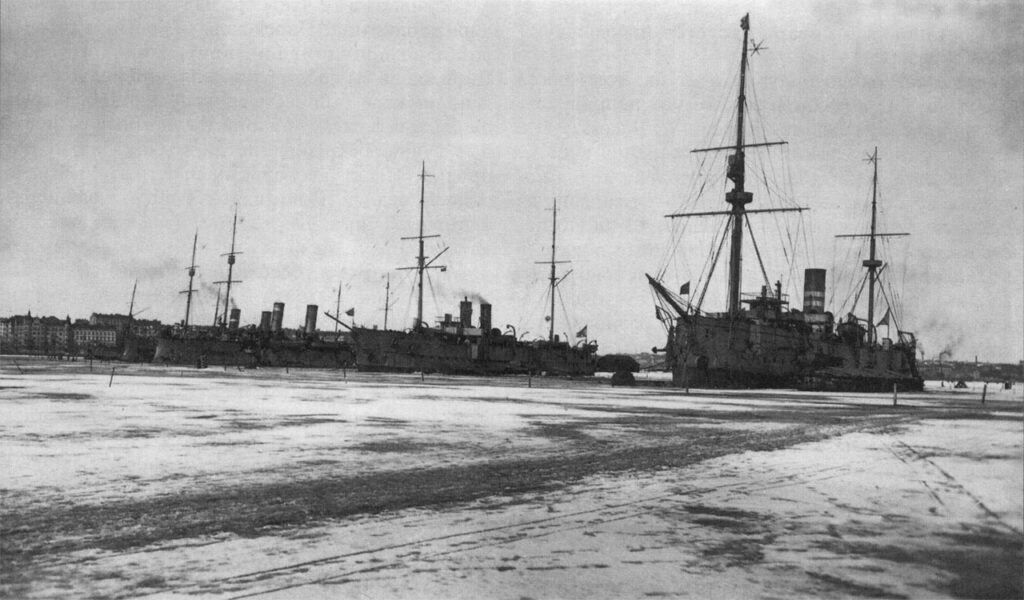
The Russian Imperial minelayers Ladoga, Onega, Amur, Ienisei and Khoper in Helsingfors after 1912. Khoper was by far the oldest, being launched in 1866.
After 1905, the Russian Navy having lost half of its naval power, more than ever bet on mines to defend its interests. When World War One brok out in August 1914, the Russian expertise reached its pinnacle during World War I. Due to the discrepancy of the forces in the Baltic, the Russian Navy had to resort to mine warfare as its primary offensive weapon. In the Baltic Sea, the knew a peak, with the use of 38,932 mines in the baltic alone, and new tactics by using both offensive and defensive mine fields (a concept in which fast mionelayers would precede a naval force and quickly lay a minefield directly in their path.
This cost the Kaiserliches Marine no less than 48 warships sunk, 21 warships badly damaged, results even better than in 1905. In 1916, the Baltic was infested so much by minefield that special missions were devised to send minesweepers with an escort, degenrating in battles. In 1916, eleven Hochseetorpedoboote en route to raid a Russian force was driven off by a minefield after seven had been sunk, more than 50% of the flotilla. Many mines were also laid down in the Black sea as well, for a grand total of 52,000 mine and 64 warships sunk, including Turkish ones.And this was only for warhips, the number of enemy transports and auxiliaries lost to maines is virtually unknown and probably in the order of 150 vessels or more.
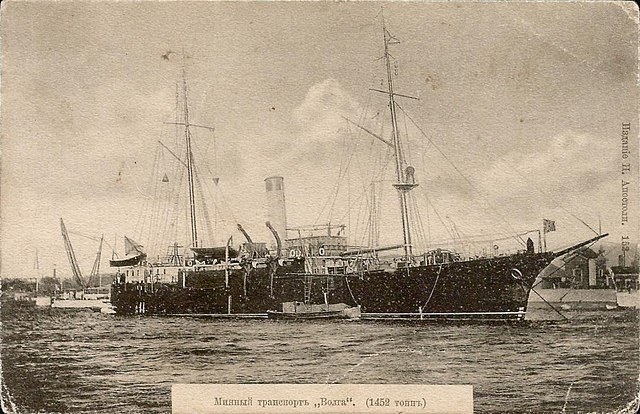
The minelayer Volga as built, postcard by Apostoli
However in the post war years an assessement was made to judge the efficiency of mines. It was calculated that it took on average 800 mines so sink a single warship. Compared to the 308,700 mines aid by all belligerents durring WWI, this was still favourable, as it represented 1,500 mines per ship. Russian mine tactics as a result were seen twice as effective as other belligerents, but it is in part explaines by the confines of the Baltic and black sea, where numerous island channeled ships towards minefields easier. Nevertheless, the Russian were quite proficient in this art, inventing notably the “flying minefields”, as said above, directly into the path of an approaching fleet.
Technical history
The first Russian mines used contact fuzes, and some even shore control (by cable) plus simple gunpowder. In 1876-1908 galvanic caps started to be use so that mines became fully independent, and their fuse used both platinum or an electrical device as a trigger. The common explosive in 1876 became gun cotton. Past 1908 mechanical percussion for their primed fuzing was used and TNT as explosive. Eventually magnetic mines were introduced from 1939, used until 1942. Russia was also a pioneer in minesweeping. During WWI, they invented the Oropesa sweep, essentially a “wire sweep” trailed behind the minesweeper, cutting cables circa eighty meters from the ship.
Generally each vessels carried two sweeps, for each side. The Soviet Navy also provided its cruisers and destroyers paravanes, this time to have them trailed from the bow. Each flotilla had a lead ship for the sweep formation, guiding all vessels in the minefield. 10% of them were sunk in action, but the training vessels at the rear, needed also to avoid and destroy the mines cut out by the lead formation. The Oropesa gear was only soccessful against moored mines, like the Paravane. German bottom magnetic mines led to the Soviets to develop an influence sweep gear, which plans were passed via lend-lease by the British having paid a great price to them in the early weeks WW2.
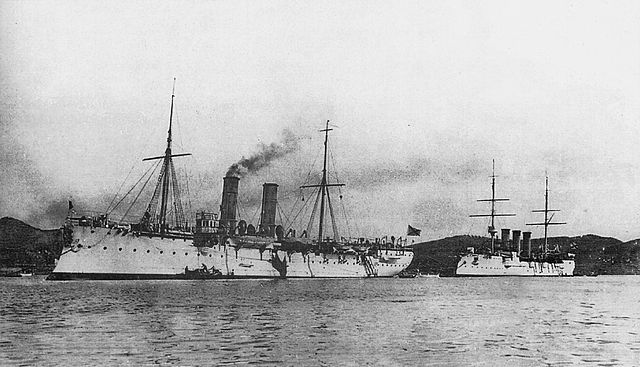
The Minelayer Ienisei(ii) and cruiser Boyarin. The first 1898 Amur class was considered so successful that after their loss at Port Arthur the naval staff dcided to replicate them in 1906. The second ships served in WWI and under the Soviet Navy.
Designations
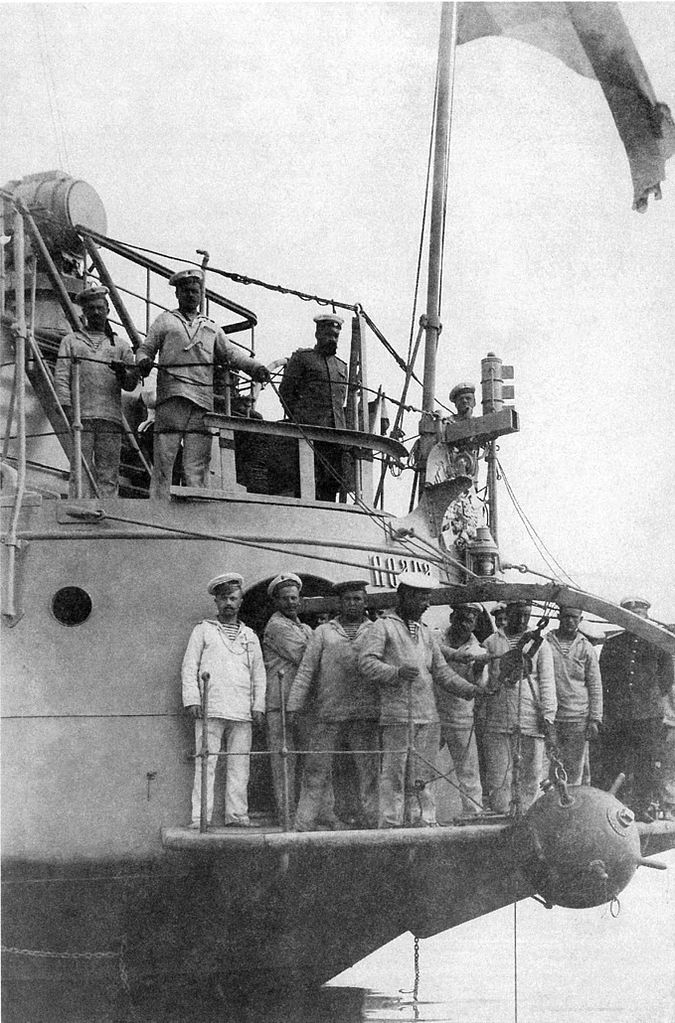
Volga showing her stern ports and chutes
-Before 1898, Russian mines were received a designation made from the designer name and introduction year.
-In WWI this was down to the model year only.
Russian Mines in service:
Model 1898: Moored contact, 123 lbs. (56 kg) Gun-cotton warhead, Trigger/Fuze 5 Hertz horns, max Depth 130 feet (40m)
Model 1906: Same, modified M1898 with new anchor and others improvements. Both were still in storage in some place, but retired as obsolete well before WW2.
Model 1908: 1268 lbs with 254 lbs (115 kg) TNT warhead, 5 Hertz horns, max depht 360 feet (110 m): The was the standard Russian mine of WWI, used with multiple iterations until the 1960s.
Model 1912: 1323 lbs. (600 kg), 221 lbs. (100 kg) warhead, max depht, 425 feet (130 m), mod M1909 with hydrostatic system for automatic depth setting
P-13: Floating mine with electrical flotation system prototype
“Rybka” 1915: Small 418.9 lbs. (190 kg) 20-27 lbs. (9 – 12 kg) warhead, percussion mechanical fuze, max depht425 feet (130 m), riverine mine.
PL-100 1915: 221 lbs. (100 kg) warhead, percussion mechanical fuze, max depht 425 feet (130 m), submarine model, tube-launched.
Model 1916: 1654 lbs. (750 kg), warhead 254 lbs. (115 kg), trigger 5 Hertz horns, max depht 1,400 feet (425 m), great depht moored contact model.
WW1 Auxiliary minesweepers and minelayers
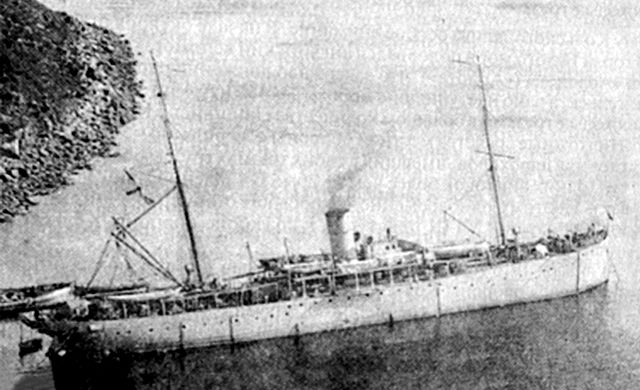
The auxiliary minesweeper Ussuri (1901)
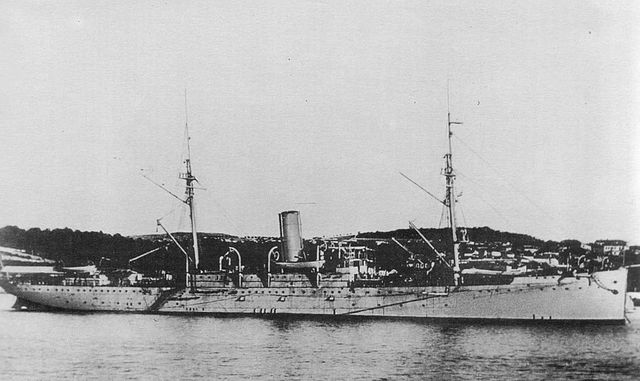
The auxiliary minesweeper prut
Auxiliary Minelayers
Baltic sea fleet
Bureya
Dyuna
Ilmen
Irtysh
Khoper
Lena
Lovat
Mtsa
Mologa
Ob
Sheksna
Svir
Terek
Ural
Zeya
Black sea fleet
Beshtau
Dikhtau
Mina
Tsesarevitch Giorgi
Velikaya Knyazinya Kseniya
Veliki Knyaz Alexiev
Veliki Knyaz Konstantin
Siberian flotilla
Monogugai
Shika
Usuri
Auxiliary Minesweepers
Baltic fleet
N°1-24 1875-1911
Alesha Popovich
Dobrynya
Dulo
Garpun
Ilya Murometz
Kitoboj
Kometa
Mikula
Namet
Nevod
Planeta
Potok Bogatyr
Stvol
Svyatogor
Tsapfa
Tumba
Yakor
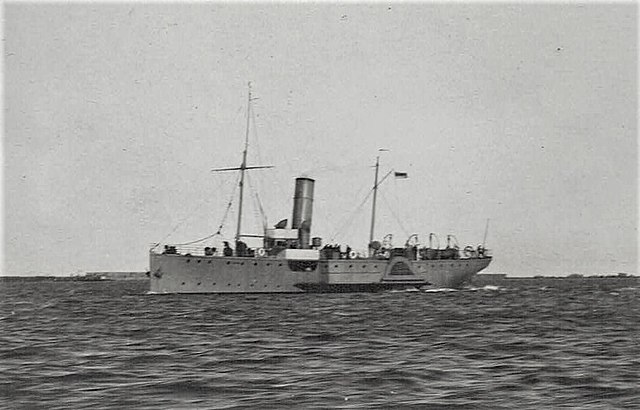
The minelayer Ristna
Black sea fleet
T 221 – T293
Batum
Kharaks
Khersonets
Metcha
Rossiya
Truvor
Vesta
Vityaz
Arctic Flotilla
T 1 – T 45
Aleksandra
Atvans
Kovda
Orezund
Sever
Svyatoi
Vera
Yug
Siberian Flotilla
Ayaks
Paris
Patroki
Uliss
Various El’Pidiror class ships
All warships but battleships could be potential Minelayers:
Less specialized, the role of minelaying could be given to any ship which could receive rails along the deck, which was the case of all cruisers and destroyers in service with the Soviet Navy in 1939. That’s why true specialized minelayers were rare, like in most navies:
–Profintern class cruisers: They carried 100 mines each, but were only completed in the interwar.
Note: The minesweepers themselves carried mines, see later. The WW2 soviet fleet of minesweepers and minelayers is currently in the writing, expecting publication later in 2024.
Nomenclature of Russian Mine ships
WWI era Minelayers
 Aleut (1886)
Aleut (1886)
The granddaddy of Russian minelayers was built in Nulandskwerft, Christiania, this schooner had deck space to store mines anf four cranes to lay them, not the fastest way to create a minefield, but a pioneering one. Classed as Schooner and reclassed as minelayer in 1911 after she was rebuilt in 1909: Her poop was modified with stern ports and chutes and her deck earned rails for a more effective delivery.
Specs: Displacement 810/892t, dims. 49.4 oa x 9.40 x 3.50m, one Vertical Compound engine, 2 cylindrical boilers 730 shp, 11.9 kts armed with four 37mm/17 Hotchkiss guns and 250 mines, crew 100. Fate: she was reconverted as a cargo in 1912 and probably out lived WWI.
 Bug class (1891)
Bug class (1891)
Bug, Dunai
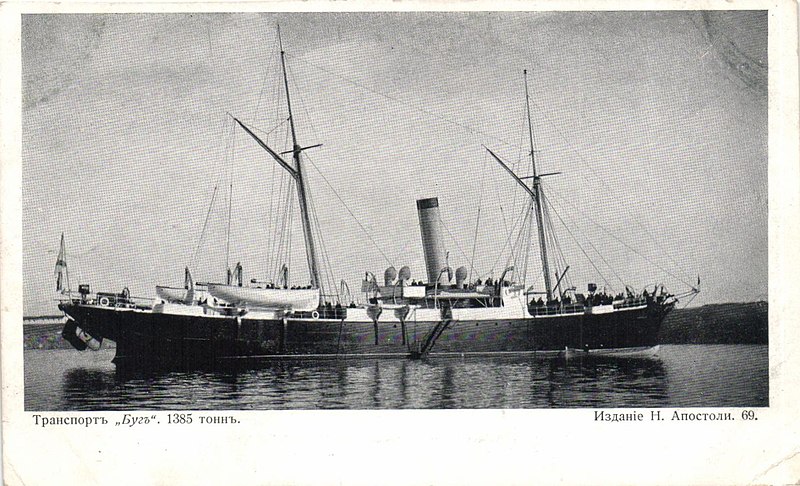
Bug, as built in peacetime colors.
A schooner-looking mined transport, experimenting with minelaying, both built at Lindholmen in 1891. Bug and Dunai were reclassed as minelayers in 1907 and both deployed with the black sea fleet. Bug scuttled in Sevastopol during the Potemkine mutiny to avoid mine explosion, and raised in 1907. Both served in WWI, Dunai was rearmed and still in service in 1941, renamed Maya since 1922.
Specs: 1382/1490t, dims. 62.2 x 10.4 x 4.60m, 2 VTE, 4 fire-tube boilers 1400 hp, 13 kts, coal 130t, range 2,150 nm at 8 kts, armed with four 47mm/40 Hotchkiss guns and carrying 545 mines, crew 226. They looked like classic yachts or schooner with their bowsprit and rigging, and that was the point for discreet operations.
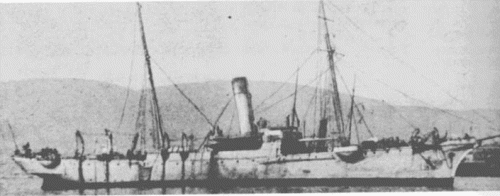
Bug in grey livery, 1912.
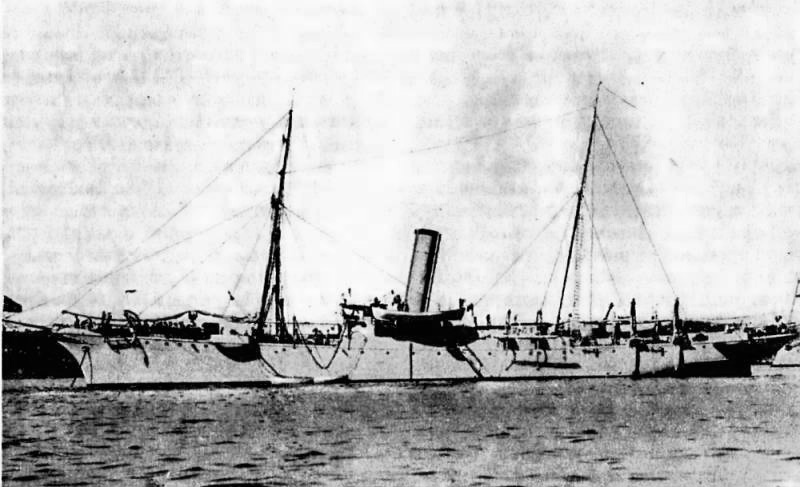
Dunai in 1900, also gray livery.
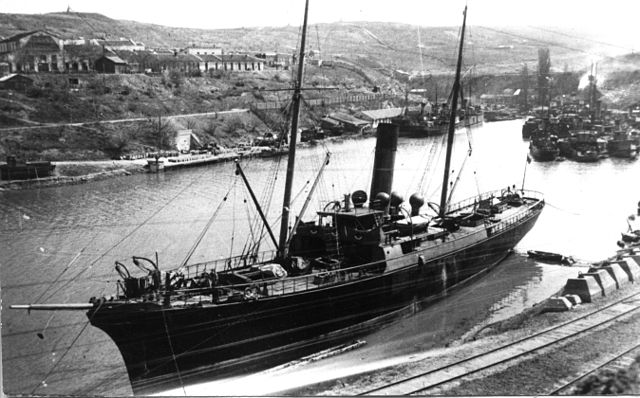
The former Dunai, now Maya in Sebastopol from 1922 to 1932
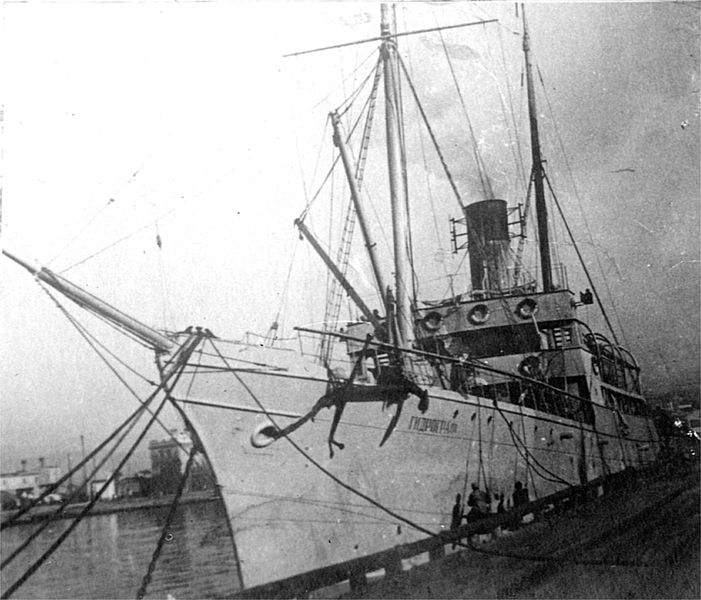
The former Dunai; ex-Maya as hydrographic vessel “Gidrograf” in 1937
 Amur class minesweepers (1898)
Amur class minesweepers (1898)
Amur, Ienisei
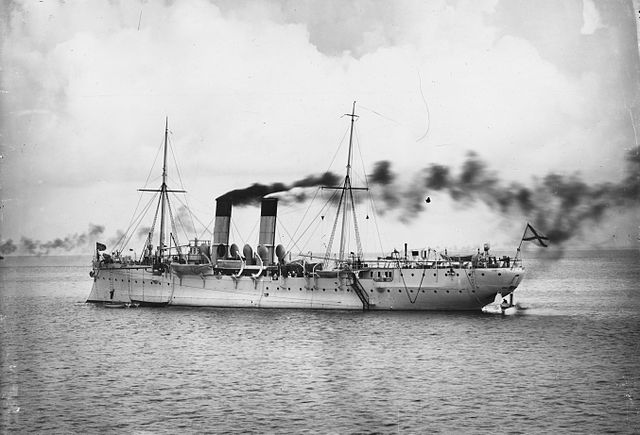
The first dedicated Russian minelayers ever. In fact they were even the first purpose-built, ocean-going minelayers in the world. Both were constructed for the Imperial Russian Navy in the late 1890s. These were closer to light cruisers in general design, faster, with better range and more heavily armed than any minelayers that came before. They will be the object of a dedicated article in the future.
During the Russo-Japanese War of 1904–05 they joined the Pacific Fleet, Yenisei striking one of her own mines and sinking but of Amur’s minefields claimed no less than the battleships IJN Hatsuse and Yashima. Amur was sunk by Japanese howitzers while refged in Port Arthur in December 1904, later salvaged and scrapped by the Japanese.
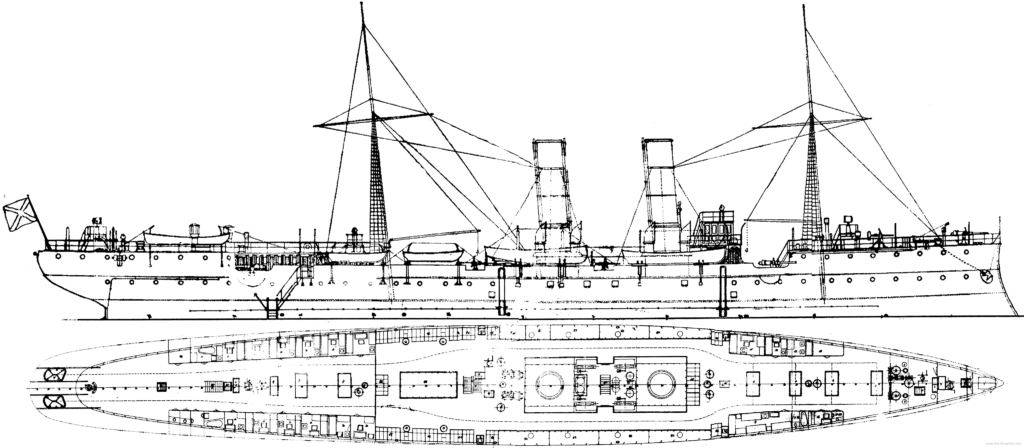
Specs: Displacement 2590/2800t, 92.7 x 14.9 x 5.20 m, 2 VTE, 12 Belleville boilers 4900 hp, 18 kts, 650t coal for 3600 nm /10 kts. Armed with five 75mm/48 Canet guns and ten 47mm/40 QF Hotchkiss and 450 mines, crew 304
 Zagraditel (1906)
Zagraditel (1906)
This vessel was Built in Crichton Abo (now Turku yard, Finland) as mine transport for the Kronshtadt naval base and employed semi-independently by the War Department. She served in WWI and on 27.2.1927 under Soviet flag she was converted as survey vessel and by 1932 renamed Azimut. At the time of Operation Barbarossa she was converted as a netlayer. On 18 October she was re-classified again as survey vessel and on 22 November while underway from Hanko, she hit a mine and sank off Kalbodagrund bank.
Specs: Displacement 388/459t; 46.3 x 7.30 x 3.05m, one VTE, 2 boilers 480 shp, 9.5 kts, 1950 nm/7 kts, only mines carried, crew 33. Not listed in Conways because of it.
 Volga (1909)
Volga (1909)
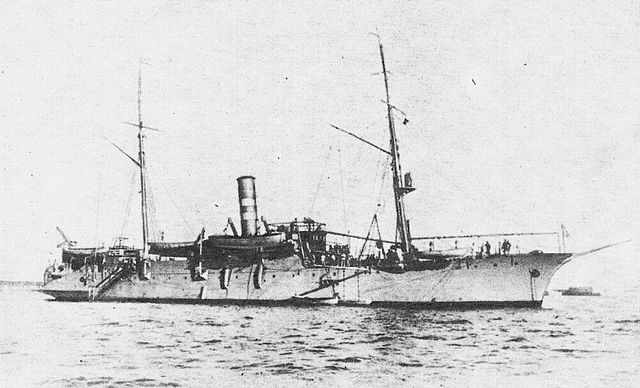
Volga was built at dedicated minelayer and auxiliary in New Admiralty, St. Petersburg, laid down in June 1903, launched in September 1904 but commissioned only by March 1909. She was also doubling as mine transport and in a peace time was to be converted as lighthouse tender and pilot ship. She was criticized for bad seaworthiness and low stability.
She missed the Russo-Japanese war but took part in WWI operations. In 1938 she discarded as depot hulk and in 1944 became a cargo, preserved to this day in St. Petersburg.
Specs: Displacement 1711t, 70.3 x 11.9 x 4.35m, 2 VTE, 4 Babcock & Wilcox boilers 1600 hp 13.5 kts, 160t coal for 1800 nm/9 kts, armed with four 47mm/40 Hotchkiss, 230 mines, crew 219.
 Amur(ii) class minelayers (1909)
Amur(ii) class minelayers (1909)
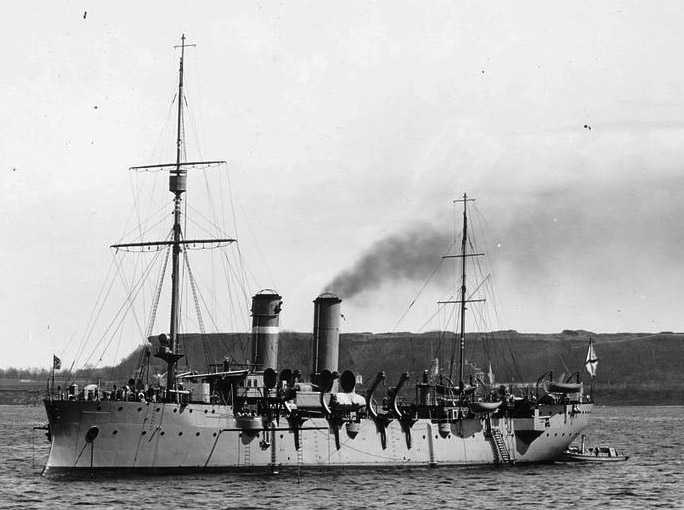
After the Russo Japanese war it was decided to rebuilt the two ships lost at Port Arthur under the same design and same name, only the armament was modernized and reinforced.
Yenisey was torpedoed on 4 June 1915 by German submarine U26 off Odensholm and Amur after the Civil war was used hulk/training vessel, scuttled at Tallinn in 1941.
Specs: Displacement 2926t, 98.9 x 14 x 4.40m, 2 shaft VTE, 12 Belleville boilers, 5000 shp 16 kts, range 3200/10 kts (650t coal), five 120mm/43 Canet, two 75mm/48 Canet, eight 7.6mm/94 Maxim MGs, 320 mines crew 312.
 Voin (1916)
Voin (1916)
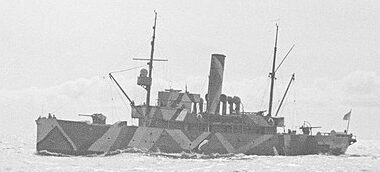
Louhi, ex Voin in WW2.
Built in Kononna Yard, and built for Sveaborg fortress, she was later transferred to the IRN. She was captured in 1918 by Finland, renamed M1 and then Louhi (see see Finland WW2). Technically she was a mine transport in Russian nomenclature, but could lay them.
Specs: Displacement 640/776t, 50 x 8 x 2.70m, one shaft VTE, 2 boilers 800hp, 10 kts armed with two 75mm/48 Canet guns and 150 mines, crew 41.
 Marti (1895)
Marti (1895)
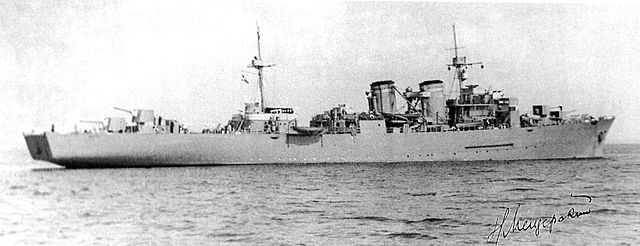
Marti was laid down originally as an auxiliary cruiser, and was completed as the emperor’s yacht “Shtandart”. In 1933 so under Soviet flag, she was converted to a minelayer in yard No194 and by 18 august 1934 renamed Marti, in November 1936 she was recommissioned in the Baltic Fleet. She is often classified as cruiser-minelayer. Note, just here for information, she will be detailed in the WW2 Soviet minelayers/minesweepers article.
 Ladoga (1866-1915)
Ladoga (1866-1915)
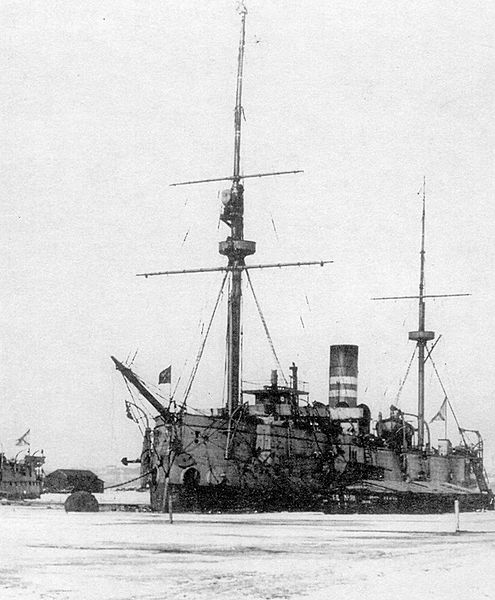
Ladoga at Helsinfors in 1912
The Ladoga is the former armoured cruiser Minin (1866). She was reconverted already in 1908 as floating mine warehouse, renamed Ladoga the next year, and recommission on October 27, 1912 as true minelayer with battery deck rails and outboard stern slopes as well as new boiler from the Black Sea Mechanical and Boiler Plant, rigging reduced and armament down to four 47 mm (1.9 in) Hotchkiss guns plus the capacity of 1000 mines, unrivalled in the world at the time.
She laid the great mine barrier of the Gulf of Finland in 1914 and was sunk on 15 August 1915 on mines from SM UC-4.
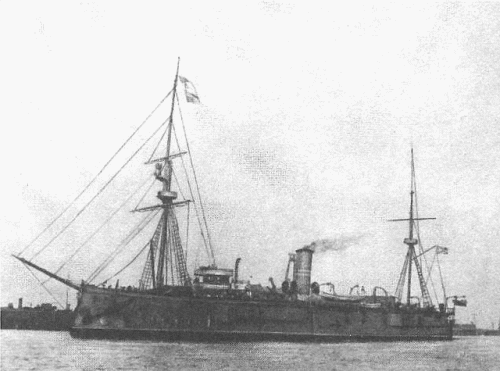
Lagoda as mine warehouse, 1909
Specs: 6,200t, 90 x 15 x 7.7 m, 4x 3.4-in and 1000 mines 6-7in (152-178 mm) belt and deck 1 in (25 mm) armor, Crew 500 1 shaft 5300 ihp 14 knots range 6000 nm/9 knots
 Onega
Onega
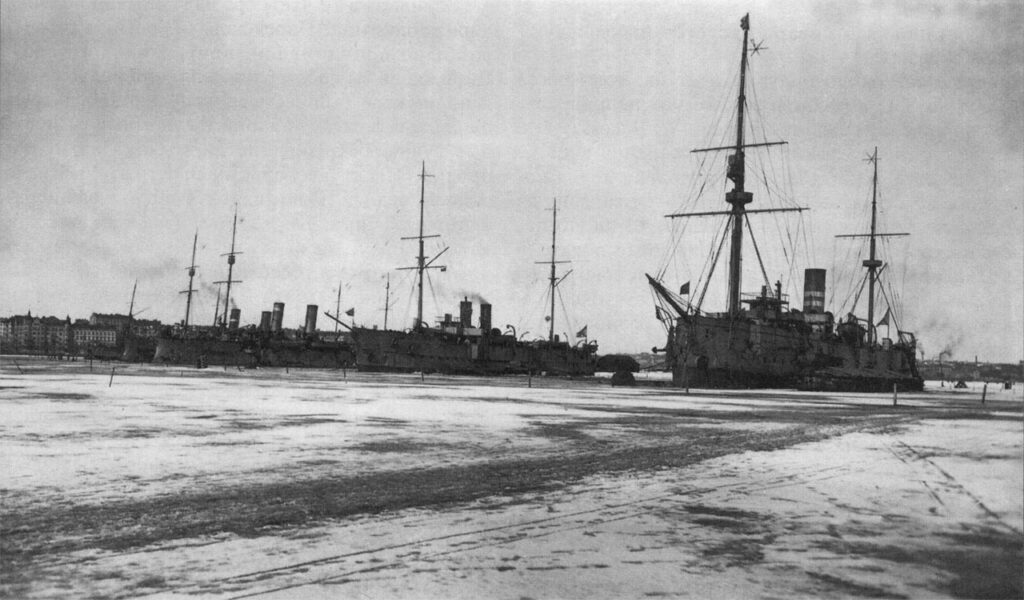
Onega was the former cruiser Gerzog Edinburgski, an armoured frigate also known as the Alexander Nevsky before being renamed on slip, launched 1875. She was used as training vessel since the early 1900s before reconstructed as minelayer Onega in 1909. In 1914 she was hulked as mine depot and was renamed Barrikada in Soviet service, BU 1949.
 Narova
Narova
She was the former armoured frigate General-Admiral (1873), a training vessel in the early 1900s and converted as minelayer Narova in 1909, training vessel by 1920 and reconstructed again as minelayer, renamed 25 Oktiabria in Soviet service, then mother-ship in 1937 and decommissioned 1944, BU 1953. No photo found as minelayer.
WWI era Minesweepers
 Harbour Minelayers (1910-14)
Harbour Minelayers (1910-14)
ALBATROS port vessels* (1909): Albatros, Baklan (Bellino-Fenderich, Odessa). 106t, 4x 37mm/20 Hotchkiss, 2 MGs, captured by German troops at Sevastopol May 1918, escaped with Wrangel fleet to Bizerte.
MINREP port vessels (1912): Minrep, Vzryv, Zapal, Provodnik, Fugas (Izhora Wks, St. Petersburg) 137t 11kts ships, one 57mm/50 Hotchkiss, 1 MG, 50 mines, First-ever “rigorous” purpose-built minesweepers, and minelayer. Provodnik, Vzryv, Fugas lost on mines. Minrep captured Finns April 1918. Zapal soviet service until 1944.
ISKRA port vessels (1914): British built (Smith Dock south bank) Iskra, Plamia, Patron. Trawler hull for Siberian Flotilla, but remained on Baltic. 420t, 11.6 kts, 2x 75mm/48 Canet, 45 mines. Iskra mined Oct. 1916, others disarmed 1923-1924, converted to trawlers RT-33 Nalim & RT-35 Forel. 1933 minesweepers T-31-33. T-31 renamed T-890, sunk 9.7.1941 Luftwaffe Zapadnaya Litsa Bay.
*The Albatros were taunted as the world’s first purpose built minesweepers.
 Gruz class (1916)
Gruz class (1916)
Shchit, Maya, Krambol, Kapsiul’, Gruz (Russo-Baltic Wks, Reval and Putilov Petrograd) launched 1916.
Shchit sunk 19.12.1916. Maya captured by Finland 4.1918 returned 1922, stricken 1925; Krambol built Putilov Yd, Petrograd captured Finland 4.1918, returned 1922, TS 1925, board guard ship 1936, stricken, same as Gruz.
Specs: 200/248-271t, 53 x 6.60 x 1-1.2m. 2 shafts VTE, 2 Yarrow boilers 650 hp 9kts 40t oil 450 kts, 75mm/48 Canet, 2 MGs. Crew 38
 T.13 class (1916)
T.13 class (1916)
Minesweepers trawlers T-13 to T-24. Built at Smith docks and Cochrane, Selby, UK. Base fishing trawler ‘Bombardier’. Icebreaker hull with streamlines and ice stiffenings.
T.15 sunk by British artillery 2.8.1918, later used by Whites, captured Reds 1920 service ww2. T13, 14, 16, 17, 20, 22 captured 1918 British troops. T19 ran ashore coast Scotland, sunk in transfer. T18 ran ashore March 1917 Kola bay, wrecked. Rest sold civilians.
Specs: 500/580t, 43.2x 7.20x 3.50m, 1 VTE, 1 Yarrow boiler 500 hp 11kts 3840 nm, 57mm/50 Hotchkiss, MG, gear, 30 mines, crew 35
 Udarnik class (1917)
Udarnik class (1917)
 Albatros class (1910)
Albatros class (1910)
 Zashnitnik class (1916)
Zashnitnik class (1916)
No info so far.
 Virsaytis class (1917)
Virsaytis class (1917)
Zadornyy, Virsaytis built in Seebeck, Geestemünde, and Neptun Yard, Rostock, Germany so different specs. Same as type 1916. M59 bought by Lithuania 1927. 1940, soviet Board Guard ship. Minesweeper 1943, sunk 11.1.1945.
M68 mined 1917 at Daugavgriva, ran aground, repaired Riga, abandoned by Germans, 1919 Soviet Latvia ‘Sarkana Latvija’. Recommissioned as Virsaitis. 1940 Soviet Baltic Fleet, sunk 3.12.1941.
Specs: 506-500t/535-539t 59.3 x 7.30 x 2.15-20m, 2 VTE, 2 Marine boilers 1750-1850 hp 16kts 120-130t oil 1000 nm. 2x 105mm/42 L/45, 30 mines or 2x 84mm/53 Škoda M.27, 2x 47mm/40 Škoda and 40 mines. Crew 57-70
 Russian WWI Netlayers
Russian WWI Netlayers
As the name indicated, Netlayers were used to carry and deployed heavy steel nets for various use: Harbour protection, ship protection, and narrow passages to deter submarines.
LUGA class netlayers (1917): Luga, Mologa, built Nizhegorodskiy Teplokhod, Nizhniy Novgorod, 1917. 220 tons, 2x 75mm/48 Canet guns, 2 MGs, 100 mines, captured Finland 1918.
BEREZINA class netlayers (1918): Berezina, Yauza built Kolomna S Yd, launched 1917, side wheels, 380t, 2x 75mm/48 Canet, 2 MGs, 120 mines. Minesweepers 1920s, netlayer 1923, stricken 1926 and 1930
KUBAN class netlayers (1918): Kuban, Terek built Kolomna S Yd, 330t, 2x 102mm/60, 6x MGs, 60 mines. Terek badly damaged river Kama May 1919, abandoned. Sister harbour vessel 1920, minesweeper 1921 and stricken 1923
ISET class netlayers (1919): Three shallow-draught crafts built at Teplokhod, Nizhniy Novgorod. The class comprised the Indigirka, later Leytenant Shmidt (launched 9.1917) and used as gunboat, auxiliary cruiser and minesweeper from 1921, stricken 1923. Moskovskiy Komsomolets/Iset and by 1945 Moskovskiy Komsomol, a command ship in 1942, gunboat in 1943, TS in 1946, stricken 1950/ Third was Selenga, BU incomplete 1919. Small 320t ships with diesels, 8.5 kts, armed with two 75mm/48 Canet guns, six LMGs and 60 mines.
Kivach class: Ordered Baltic Works Petrograd, suspended 1918, never completed. Class: Kivach, Klyazma, Seym
 Russian WW1 Minelaying boats
Russian WW1 Minelaying boats
NO1 mine motor boats (1911 – 1914): Fire shallow water, coastal motor crafts. Used as coastal minelayers and minesweepers, five built at Sevastopol Port Wks.
In 921, T-1, 2, 5 were armed with a 75mm/48 Canet gun and one 47mm/40 Hotchkiss plus new mechanical minesweeping gear. All were seized by the Germans at Sevastopol in 1918 and afterwards by British-French troops, transferred to Whites in 1919, returned to the Red Fleet, discarded 1920s.
TEPLOKHOD No1/N06 motor boats (1914):
Small motor crafts built in St. Petersburg and Finland. Teplokhod-1-13 were also called “Motorship-1-13”. Coastal minelayers/minesweepers, with M11-13 BU incomplete.
They survived until 1941 and had updated mechanical minesweeping gear for those. 1918 saw all the boats in Revel and Helsingfors. M-1, 4 and 5 were captured by Finland, M-2 and 3 by Estonia. o1502 was scuttled at Tallinn in August 1941, salvaged used as a German patrol motor launch Ks156, ORe76.
Specs: Displacement 34t, 20.7 x 5 x 1.20, 2x shafts Bolinder semi-diesels 60 hp 7.2 kts, RA 420 nm armed with single 7.6mm/94 Maxim MG, 25 mines
Sources/Read More
weaponsandwarfare.com/ naval-mine-warfare-wwii/
man.fas.org/
navypedia.org/

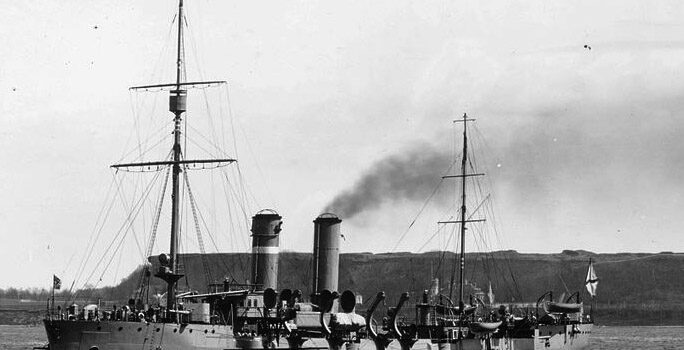
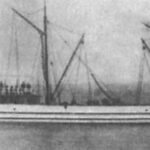
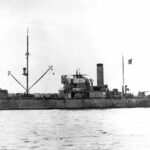
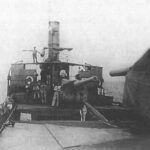
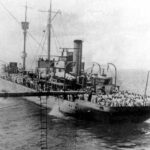
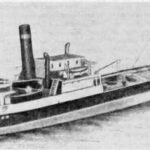
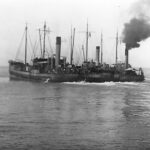
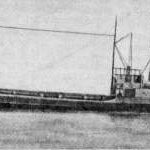
 Latest Facebook Entry -
Latest Facebook Entry -  X(Tweeter) Naval Encyclopedia's deck archive
X(Tweeter) Naval Encyclopedia's deck archive Instagram (@navalencyc)
Instagram (@navalencyc)





 French Navy
French Navy Royal Navy
Royal Navy Russian Navy
Russian Navy Armada Espanola
Armada Espanola Austrian Navy
Austrian Navy K.u.K. Kriegsmarine
K.u.K. Kriegsmarine Dansk Marine
Dansk Marine Nautiko Hellenon
Nautiko Hellenon Koninklije Marine 1870
Koninklije Marine 1870 Marinha do Brasil
Marinha do Brasil Osmanlı Donanması
Osmanlı Donanması Marina Do Peru
Marina Do Peru Marinha do Portugal
Marinha do Portugal Regia Marina 1870
Regia Marina 1870 Nihhon Kaigun 1870
Nihhon Kaigun 1870 Preußische Marine 1870
Preußische Marine 1870 Russkiy Flot 1870
Russkiy Flot 1870 Svenska marinen
Svenska marinen Søværnet
Søværnet Union Navy
Union Navy Confederate Navy
Confederate Navy Armada de Argentina
Armada de Argentina Imperial Chinese Navy
Imperial Chinese Navy Marinha do Portugal
Marinha do Portugal Mexico
Mexico Kaiserliche Marine
Kaiserliche Marine 1898 US Navy
1898 US Navy Sovietskiy Flot
Sovietskiy Flot Royal Canadian Navy
Royal Canadian Navy Royal Australian Navy
Royal Australian Navy RNZN Fleet
RNZN Fleet Chinese Navy 1937
Chinese Navy 1937 Kriegsmarine
Kriegsmarine Chilean Navy
Chilean Navy Danish Navy
Danish Navy Finnish Navy
Finnish Navy Hellenic Navy
Hellenic Navy Polish Navy
Polish Navy Romanian Navy
Romanian Navy Turkish Navy
Turkish Navy Royal Yugoslav Navy
Royal Yugoslav Navy Royal Thai Navy
Royal Thai Navy Minor Navies
Minor Navies Albania
Albania Austria
Austria Belgium
Belgium Columbia
Columbia Costa Rica
Costa Rica Cuba
Cuba Czechoslovakia
Czechoslovakia Dominican Republic
Dominican Republic Haiti
Haiti Hungary
Hungary Honduras
Honduras Estonia
Estonia Iceland
Iceland Eire
Eire Equador
Equador Iran
Iran Iraq
Iraq Latvia
Latvia Liberia
Liberia Lithuania
Lithuania Mandchukuo
Mandchukuo Morocco
Morocco Nicaragua
Nicaragua Persia
Persia San Salvador
San Salvador Sarawak
Sarawak Uruguay
Uruguay Venezuela
Venezuela Zanzibar
Zanzibar Warsaw Pact Navies
Warsaw Pact Navies Bulgaria
Bulgaria Hungary
Hungary

 Bundesmarine
Bundesmarine Dutch Navy
Dutch Navy Hellenic Navy
Hellenic Navy Marina Militare
Marina Militare Yugoslav Navy
Yugoslav Navy Chinese Navy
Chinese Navy Indian Navy
Indian Navy Indonesian Navy
Indonesian Navy JMSDF
JMSDF North Korean Navy
North Korean Navy Pakistani Navy
Pakistani Navy Philippines Navy
Philippines Navy ROKN
ROKN Rep. of Singapore Navy
Rep. of Singapore Navy Taiwanese Navy
Taiwanese Navy IDF Navy
IDF Navy Saudi Navy
Saudi Navy Royal New Zealand Navy
Royal New Zealand Navy Egyptian Navy
Egyptian Navy South African Navy
South African Navy






























 Ukrainian Navy
Ukrainian Navy dbodesign
dbodesign